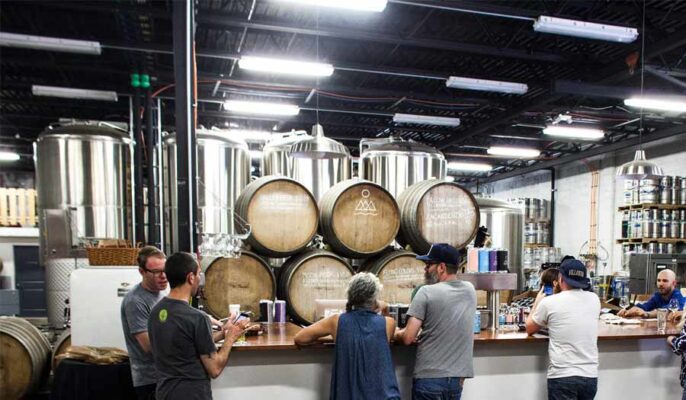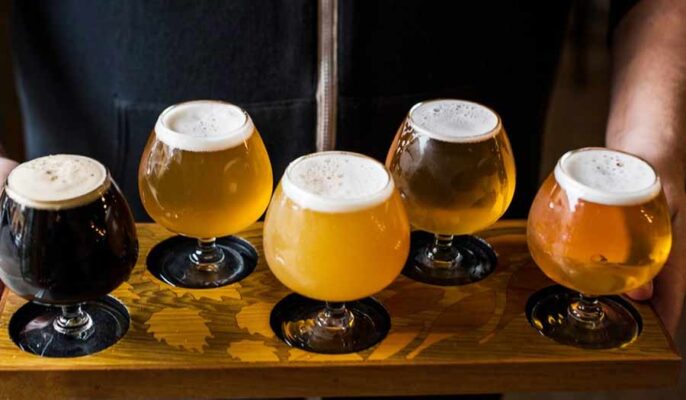Bier wordt gemaakt van vier basisingrediënten: gerst (of andere granen), water, hop en gist. Het basisidee is om suiker uit het graan te halen, dat vervolgens door gist wordt omgezet in alcohol en kooldioxide om bier te maken. Brouwen is een combinatie van wetenschap en kunst. Brouwers gebruiken een wetenschappelijk basisproces en gaan creatief te werk door de combinatie van granen, hop en gist te variëren om een breed scala aan bierstijlen te produceren.
Wat is ambachtelijk bier?
Craft bier wordt meestal gebrouwen door onafhankelijke brouwerijen met traditionele ingrediënten zoals mout, hop, water en gist, en wordt vaak in kleinere hoeveelheden geproduceerd. Omdat het om ambachtelijk bier gaat, wordt er bij het proces om ambachtelijk bier te maken vaak meer aandacht besteed aan details dan bij bieren die in massa geproduceerd worden, wat resulteert in unieke smaken en producten van hogere kwaliteit.
Kenmerken van ambachtelijk bier:
- Jaarlijks worden niet meer dan 6 miljoen vaten bier geproduceerd
- Niet-ambachtelijke brouwerijen kunnen minder dan 25% van de aandelen van de brouwerij controleren
- Het bier zelf is minstens één van de belangrijkste producten van de brouwerij of is goed voor meer dan 50% van de verkoop
- Er worden geen supplementen gebruikt bij het maken van het product
- Geen kunstmatige toevoegingen of smaakstoffen

Ingrediënten in ambachtelijk bier
- Mout: Alle bieren beginnen met mout. Traditioneel bestaat mout uit gerst, maar haver en rijst kunnen ook worden gebruikt. De granen worden geroosterd en gedroogd en vervolgens gemalen om de enzymen vrij te maken die nodig zijn om bier te brouwen. De mout bepaalt de kleur van het uiteindelijke bier. Licht branden geeft het bier een lichte kleur. Donker branden maakt het bier ook donkerder.
- Hop: Hop speelt een belangrijke rol bij het brouwen van bier. Ze geven bier de citrusachtige, aardse smaak die we allemaal kennen en waar we van houden. Er zijn veel verschillende soorten hop en elke soort geeft het bier een andere smaak. Veel brouwers mengen meerdere hopsoorten om complexere smaken te creëren. Zo krijgt Tropigamma zijn sappige, fruitige smaak. Of de reden waarom Neck Oil een meer rustieke smaak krijgt.
- Water: Je kunt geen bier maken zonder water! Bier bestaat voor 90-95% uit water. Water beïnvloedt de smaak van het uiteindelijke bier. Hard water geeft zacht water een andere smaak door de mineralen die in het water opgelost zijn. Daarom smaakt bier over de hele wereld anders, zelfs als ze dezelfde mout en hop gebruiken!
- Gist: Gist is het laatste ingrediënt dat nodig is om bier te brouwen. Gist wordt toegevoegd om het mengsel te laten gisten. Het breekt de suikers en koolhydraten af en zet ze om in alcohol om van te genieten aan de bar.
Hoe brouw je ambachtelijk bier?
Malen en pureren
Malen is de eerste stap in het bierbrouwproces. Het maalproces houdt in dat granen zoals mout, gerst, tarwe, rogge, haver of maïs in kleine stukjes worden gemalen voor het brouwen van bier. De zaden ondergaan een moutproces. Het doel is dat de zaden beginnen te ontkiemen alsof ze gaan groeien. Ontkiemen activeert het enzym amylase, dat nodig is om vergistbare suikers te produceren wanneer gist aan het proces wordt toegevoegd.
De kieming moet echter op het juiste moment worden gestopt. Graan dat van het veld wordt geoogst bevat meestal 10% tot 12% vocht en door weken (onderdompelen in water) stijgt het vochtgehalte tot ongeveer 45%, waardoor het gaat kiemen. Als het onbehandeld blijft, zal het graan wortelen en ontkiemen. Wanneer het ontkiemen stopt, wordt het graan gedroogd door het te drogen en wordt het vochtgehalte verlaagd tot 3 tot 5 procent. Het laatste stadium is het roosteren van het graan. De mouters (specialisten in het maken van een verscheidenheid aan gemoute granen) beslissen over het type roosteren.
Puree
Bier brouwen begint met één enkele stap. Tijdens het maischen wordt mout gemengd met heet water. Zoals de naam al zegt, is mash het proces waarbij droge gerst, tarwe en/of andere granen in water worden gemengd tot een kleverige substantie die lijkt op een dunne pap. Dit is de moutstroop.
Omdat de mout gedeeltelijk geplet wordt voor het weken, kan het hete water in elke korrel doordringen, waardoor het natuurlijke zetmeel bloot komt te liggen. Dit is precies wat brouwers willen, want deze zetmelen worden door de enzymen van het graan omgezet in suikers. Deze suikers worden vervolgens gebruikt als voedselbron door de gist om alcohol en kooldioxide te produceren. Vanuit de moutsiroop beginnen de grote dingen.
Filtratie
Door de vaste deeltjes achter te laten, kan de vloeistof verder veranderen in bier. Door meer water aan de bovenkant van het graanbed toe te voegen, sijpelt het water er doorheen en wordt de zoete, suikerachtige vloeistof meegenomen. Deze stap wordt gedaan in de oorspronkelijke wortemmer of in een aparte container die filtertank wordt genoemd, maar beide hebben een geperforeerde bodem nodig om de vloeistof eruit te laten stromen.
In het begin wordt de uitstroom van wort (nu wort genoemd) troebel door ongewenste hullen en andere deeltjes. Brouwers brengen deze eerste uitstroom van wort meestal terug naar de bovenkant van het graanbed voor verdere filtratie.
Filtratie helpt het wort te klaren en verwijdert ongewenste eiwitten en andere deeltjes die de smaak en helderheid van het bier kunnen beïnvloeden.
Kokend
Het wort wordt overgeheveld naar een ander groot vat om opgewarmd te worden. Het wort zal in dit grote vat meer dan een uur krachtig koken - afhankelijk van de bierstijl. Deze langdurige verhitting stopt de enzymactiviteit in het wortstadium, fixeert de hoeveelheid suiker die beschikbaar is voor de gist en ontsmet tegelijkertijd het wort. Vanaf dit stadium moet alles wat het bier aanraakt steriel zijn. Brouwers zijn beruchte schoonmakers.
De kookfase is meestal ook de fase waarin hop wordt toegevoegd. We voegen vaak hop (en soms zelfs wort) toe tijdens het filtreren om smaak toe te voegen, maar aan bijna elk bier dat je drinkt, wordt hop toegevoegd tijdens het koken. Dit komt doordat warmte de interne structuur van hop verandert, waardoor alfa- en bètazuren vrijkomen, en zorgvuldig getimede toevoegingen maken een verschil. Hoe vroeger de hop wordt toegevoegd, hoe bitterder de smaak. Latere toevoegingen zijn meer voor aroma en smaak.
Gisting
De wort wordt overgeheveld naar de gistingsvat en de gist wordt toegevoegd. Ale gist drijft naar de bovenkant van het wort, terwijl lager gist zich meestal op de bodem verzamelt. Dit stadium is primaire gisting - de omzetting van suiker in alcohol en koolzuurgas om een ale of lager te produceren, afhankelijk van het type gist dat wordt gebruikt.
Zodra de gist op de juiste temperatuur is gebracht, wordt de temperatuur van het bier meestal op 60 tot 68 graden Fahrenheit (voor ales) en 50 graden Fahrenheit (voor lagers) gehouden. Het proces waarbij de gist suiker omzet in alcohol genereert warmte en wordt nauwlettend in de gaten gehouden door de brouwer. Hoe hoger de temperatuur van de ale gist, hoe meer esters of aromatische organische verbindingen er worden geproduceerd.
Fermentatie is het proces waarbij suiker wordt omgezet in alcohol en kooldioxide. Het is het belangrijkste onderdeel van het brouwproces en de sleutel tot het maken van heerlijk ambachtelijk bier. Tijdens de gisting verbruikt de gist de suikers in het wort, produceert alcohol en brouwt het bier.
Bier bewaren
Tijdens de gisting van moutbieren en lagers wordt het bier rijper en zachter en worden de gistingsbijproducten gereduceerd. In dit stadium kan droge hop worden toegevoegd om het aroma te verhogen en andere methoden zoals vatrijping kunnen het bier nog complexer maken. Het bier wordt tot 30 dagen gekoeld (bekend als "bewaarbier") en een van de belangrijkste verschillen tussen bewaarbieren en moutbieren is dat ze schoner zijn en meer uitgesproken smaken hebben.

Verpakking en koolzuur
Nadat het bier is uitgegist, moet het op vat of fles worden gedaan en op natuurlijke of geforceerde wijze worden gecarbonateerd. Geforceerde carbonatatie houdt in dat koolzuurgas onder hoge druk aan het vat wordt toegevoegd om het te dwingen door het bier te worden opgenomen. De meeste brouwerijen gebruiken geforceerde carbonatatie omdat het een sneller proces is dat resulteert in een helderder bier. Zodra het bier verpakt en belucht is, is het klaar om gedronken te worden. Verpakken en beluchten zijn de laatste stappen van het brouwproces en ze spelen een belangrijke rol in de kwaliteit en houdbaarheid van het bier.
FAQ
Wat is de houdbaarheid van ambachtelijk bier?
Over het algemeen moet ambachtelijk bier binnen drie tot zes maanden na de productiedatum gedronken worden. Voor de beste smaak kun je ambachtelijk bier het beste op de juiste temperatuur en uit direct zonlicht bewaren.
Wat is het verschil tussen ambachtelijk bier en gewoon bier?
Het belangrijkste verschil tussen ambachtelijk bier en gewoon bier is het brouwproces en de schaal van de productie. Ambachtelijke brouwers geven voorrang aan kwaliteitsingrediënten, praktische brouwtechnieken en experimenten, wat resulteert in bieren die vaak lekkerder en complexer zijn dan in massa geproduceerde bieren.
Brouwen microbrouwerijen bier of ambachtelijk bier?
Microbrouwerijen zijn vaak synoniem met ambachtelijke brouwerijen, aangezien beide termen verwijzen naar kleine, onafhankelijke ambachtelijke brouwerijen. Het is echter mogelijk dat sommige microbrouwerijen niet voldoen aan de strenge normen die zijn opgesteld door organisaties uit de ambachtelijke bierindustrie, zoals de American Brewers Association.
Wat is het verschil tussen ambachtelijk bier en commercieel bier?
Craft bier en commercieel bier verschillen in alle aspecten van brouwmethoden, ingrediënten en doelgroepen. Craft bier richt zich op kwaliteit, innovatie en betrokkenheid bij de gemeenschap, terwijl commercieel bier zich richt op massaproductie, brede distributie en jaarlijkse verkoopopbrengsten.




